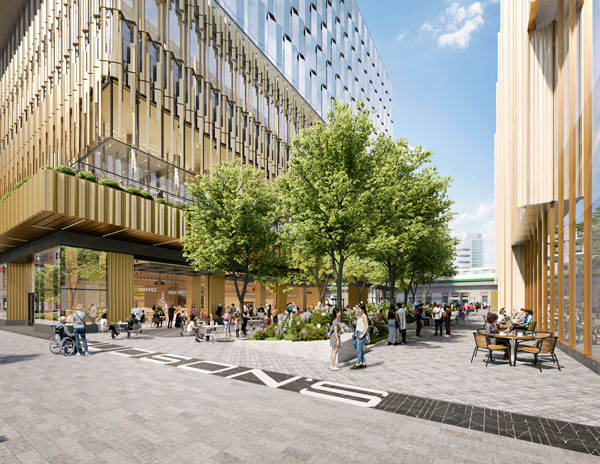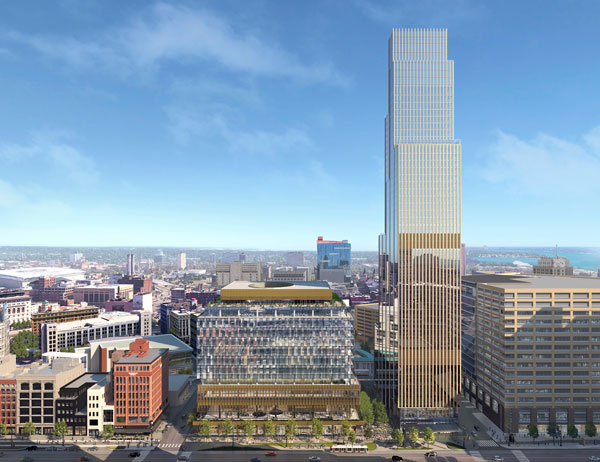What was once the anchor for downtown Detroit will be replaced with what’s expected to be a new anchor for the 21st century.
The site of the former Hudson’s department store, a block long edifice and one time world’s tallest department store at 32 storeys, will be replaced by two modern towers that should equally transform the Motor City’s core skyline.
Constructed by Bedrock, part of Detroit-based Rock Ventures, which includes companies like trailblazing online firm Rocket Mortgage, the $900-million, 1.1-million-square-foot structures will take up the same city block on Woodward Avenue, the downtown’s traditional shopping street.
There’s no official name for the project, at least yet, with the builder simply referring to it as the “Hudson’s Site.”
There will be one 29 storey tower encompassing almost 230,000 square feet of residential space and 300,000 square feet for what’s expected to be a high-end hotel.
Meanwhile the smaller 11 storey midrise building will have 400,000 square feet of “tech-forward” office space, a soaring central atrium and an exhibition or event center.
But these towers won’t be sterile highrises. A “carefully curated” retail, dining and entertainment plaza will be built between the two buildings, according to the developer. And garage-like doors will unfold on the street creating a market effect designed to attract passing pedestrians.
And just like the old Hudson’s store brings back memories for millions of Detroiters, the new property may be similarly destined. As Bedrock CEO Kofi Bonner said in a statement, “The reinvigoration of Detroit’s most centrally located site will become a must-see location and will generate fond memories for Detroiters and visitors for generations to come.”
New York City-based SHoP along with Detroit’s Hamilton Anderson Associates are the designers. Detroit’s Barton Malow is the general contractor.

Bedrock has transformed Detroit’s downtown over the past couple of decades. Led by businessman Dan Gilbert the company has bought up scores of once derelict buildings and converted them to offices, apartments and commercial districts. The Hudson’s Site will be the company’s centerpiece.
But the project, as grand as it is, has had growing pains.
It has been six years since ground was broken in December 2017. The lead tower has had to be downsized. Originally it was to be Detroit’s tallest skyscraper, taller than the riverfront Renaissance Center’s 73-storey Marriott Hotel.
A weak downtown real estate market plus the aftermath of the COVID-19 pandemic have been blamed for the changes. And there is competition with the up and coming The District Detroit, several massive residential and commercial buildings on tap by Olympia Development, part of the group that owns the Detroit Red Wings and Detroit Tigers.

Despite this, Carolyn Loh, professor in the department of urban studies and planning at the city’s Wayne State University, says the project, downscaled or not, might work.
“I have seen an enormous change in the number of people who consider downtown to be a desirable place to live,” she said.
Fuelled by tech workers and millennials “it’s just a radically different vibe and view of downtown as a neighborhood.”
Loh said while office space is a “separate issue” the city still has “lower office vacancy rates than other large U.S. cities so I guess I’m cautiously optimistic on that front.”
John Gallagher, a long time Detroit business writer, author, and follower of urban development issues, also thinks the revised project fits.
“It doesn’t quite match the original concept but it’s pretty close,” he said.
Besides the “Jane Jacobs”-like plaza and market which should create a community space, Gallagher described the buildings themselves as “mainstream modernist” but not glitzy post-modernist.
“It’s not trying to take 1,500 design elements and stick them on a modern building.”
The larger building, after years of incremental construction, is now a partially completed framed structure starting to loom over the core.
“No matter how you approach downtown it’s very visible,” Gallagher says.
The project has not been without critics as major downtown development projects generally have been. The main lament has been public financing. Bedrock will receive $192.8 million in tax increment financing over 30 years and other breaks like a sales tax exemption on construction materials.










Recent Comments
comments for this post are closed